A well-known figure in the pig industry, Con O’Kelly has been expanding the business since he came home from ag college in the 1980s.
The home farm had been a 95-acre dairy and pig farm outside Borris village, Co Carlow, with Con adding a second farm to the system in 1988; a 15 acre 70-sow farm in Roscrea, Co Tipperary.
Now, Con keeps the 680 breeding sows on the Roscrea farm, while weaners and fatteners are all kept in the Borris yard.
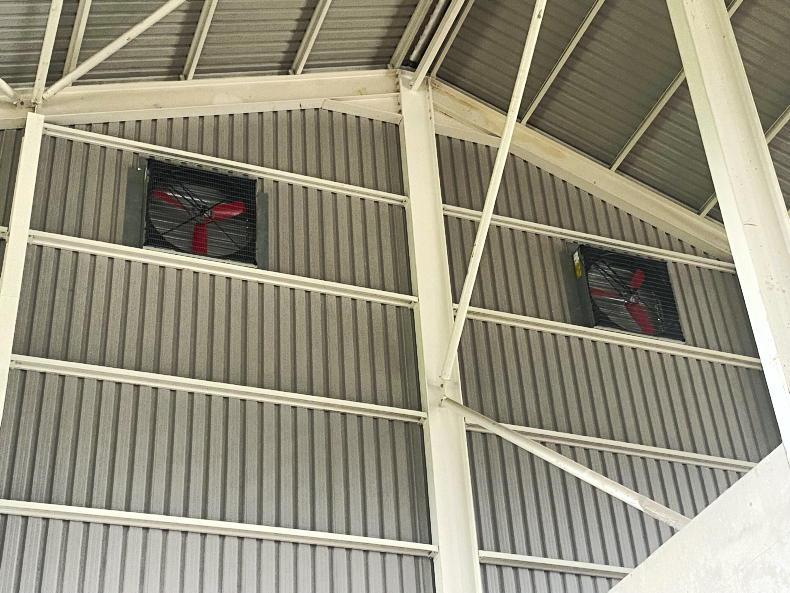
Two large fans have been installed at the rear to remove warm air from the store.
As well as the recently completed pig units and an impressive machinery shed with a pit, one of the more unusual and prominent features in Con’s yard is a new grain store, used to store straight feedstuffs, with Con having his own milling and batching facility on site to create the various different rations for the individual batches of pigs.
A grain store but no tillage
You’d be forgiven for thinking that Con is growing his own feed, thereby needing the grain store. But no, Con grows none of the grain himself, but sources it from local farmers and transports it to the Borris yard via lorry.
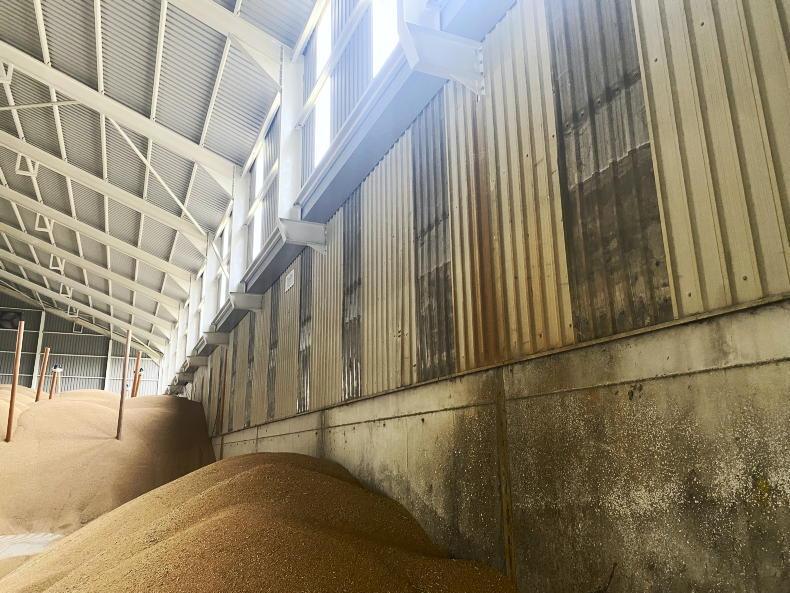
The new build was grafted on to the smaller grain store next door but extends 60ft beyond this.
The grain is then tipped up, where it had traditionally been dried pre-storage using an oil powered grain drier. Last year and this year, propcorn was used to treat the grain instead of drying, with the cost being €10/tonne cheaper than drying while also retaining the moisture in the grain for the pigs.
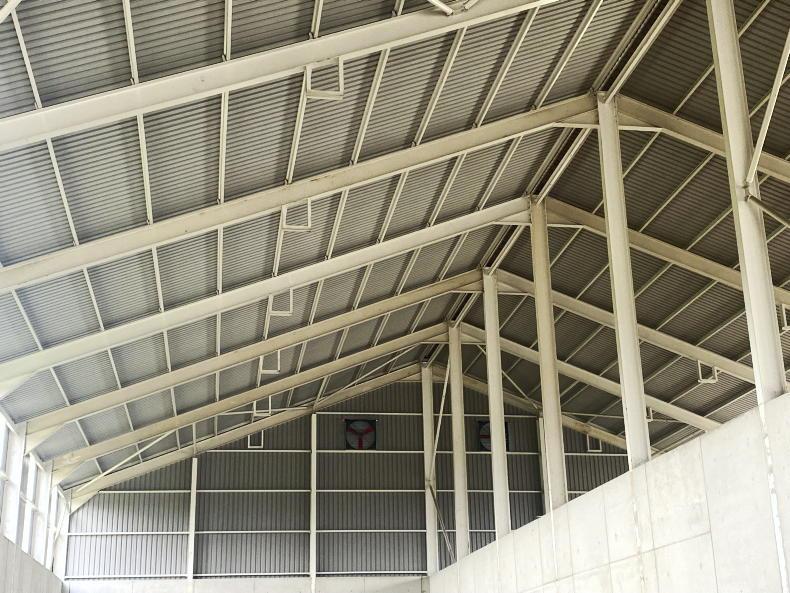
All RSJs are painted white by Con to brighten the building. Non-drip steel cladding was used. The brackets for the grain conveyor can be seen in the roof rafters.
Con solely manufactures ration for his own farm, with roughly 200 tonnes of finished ration per week. Con has a preference for buying his grain off the field explaining ‘’Four out of every five years, you will work out better this way from a cost point of view’’.
A grain store with a 2,500 tonnes capacity has been in place since 2001, but the lack of storage was resulting in the purchase of grain throughout the year. As a result, Con decided to build a larger capacity store to better secure his grain requirements for his farm
10,000 tonne capacity
A 200ft x 100ft (60.9m x 30.5m) new store was then built this year capable of holding 10,000 tonne of grain. The new store runs alongside the existing one, with the grain treatment at the front with the new grafted on to the existing one in places.
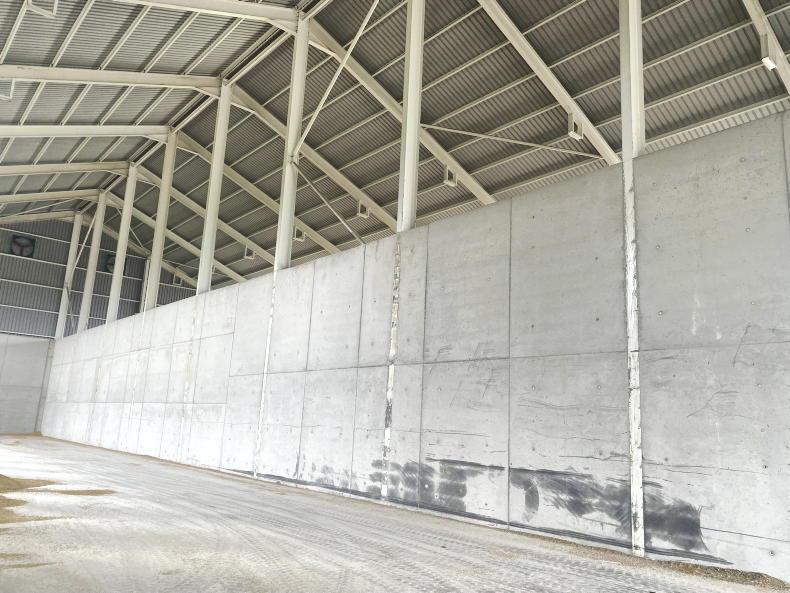
The central and external walls rise to 22ft and are 18in in thickness. The centre of the shed rises to 47ft.
A bay of a common wall was removed, meaning the two grain stores sit in under the one large roofed area.
The store is split in to two, with a central dividing wall with upright RSJs running through the centre.
Barley feed will be on one side, with wheat feed on the other.
The old shed will be used for storage of maize, soyabean meal and other less used grains which are delivered throughout the year.
Both the central wall and external walls are 22ft high, with an 18 in (450mm) width used, as well as reinforcement with rebar. Con painted the RSJs in the shed white, something he has done in other buildings in the yard ‘’to help brighten up the appearance’’.
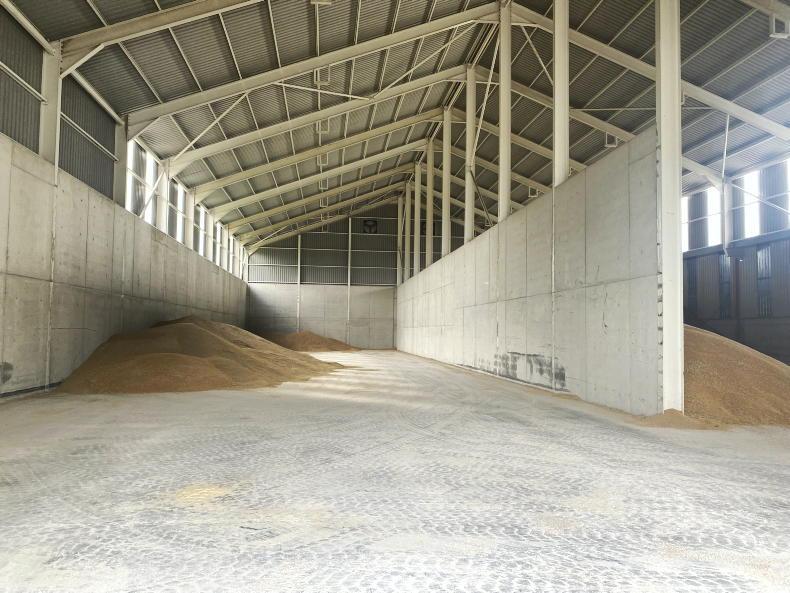
Barley grain is to be stored on the left, with wheat feed on the right. Maize and soya will now be stored in the smaller grain store.
The store rises to 47ft (14.3m) in the centre and 33ft (10.05m) at the eaves. Non-drip steel cladding is used in the roof, while clear sky lights were used on some of the sides to brighten the inside while working in the daytime. Galvanised steel purlins were also used for longevity.
Grain conveyor
Additional brackets were welded to the roof girders on both sides. Con’s plan is to install a conveyor on both sides of the shed to transport the grain from the front of the shed, where it is treated, to further back the shed for storage.
For now, Con is shovelling and pushing the grain up with a loader as he awaits his elevator system to come from the UK.
The floor is 10in (250mm) thick and reinforced, which is finished to a smooth surface for ease of cleaning. Con opted not to go for underfloor ventilation as he felt it required a lot of maintenance, so a pedestal ventilation system was installed instead.
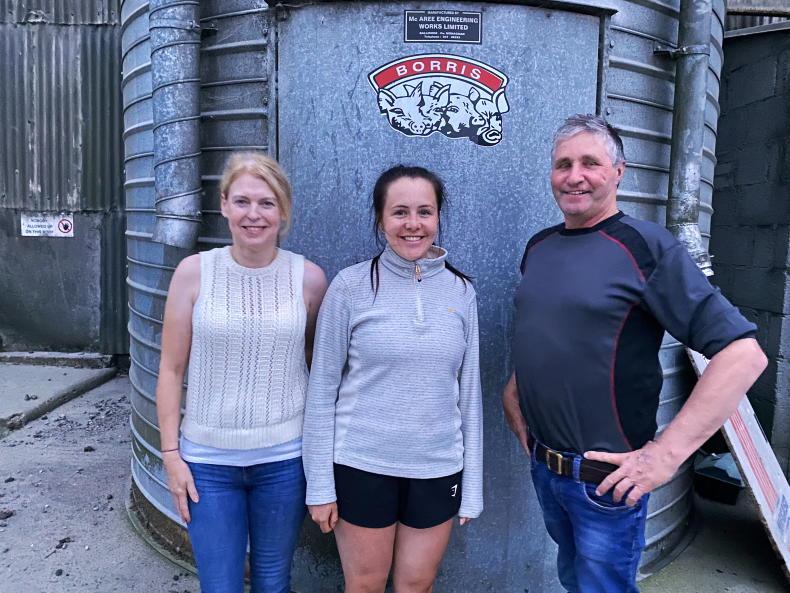
Geraldine Murphy, Tara Treacy and Con O'Kelly(O'Kelly Feed Mills).
Two large fans are also installed along the back of the wall to remove hot air.
A 20ft (6m) electric door is installed at the front of the new shed for ease of access with loaders or lorries, as well as a smaller pedestrian door. The shed is ideally located beside the weigh bridge to monitor grain intakes.
Cost
Due to the size and cost of the shed, after researching it Con felt the TAMS grant aid was not for him so constructed the shed without it. JP Murphy Bros Ltd., based in Enniscorthy took on the main contract of supplying and erecting the building, with the entire structure and concrete works completed in six weeks.
Con was extremely happy with the quality of work and the turnaround time on the shed, with this year’s harvested grain now starting to fill it up.
To supply and fit the structure, including all RSJs, sheeting and purlins cost €220,000 + VAT; 1,200m³ of concrete went in to the entire shed at a cost of €110/m³ equating to €134,000 + VAT, while the labour for the concrete works (shuttering walls and pouring floors) came to €90,000 + VAT. All in the shed is coming to a total of €444,000 + VAT.
A well-known figure in the pig industry, Con O’Kelly has been expanding the business since he came home from ag college in the 1980s.
The home farm had been a 95-acre dairy and pig farm outside Borris village, Co Carlow, with Con adding a second farm to the system in 1988; a 15 acre 70-sow farm in Roscrea, Co Tipperary.
Now, Con keeps the 680 breeding sows on the Roscrea farm, while weaners and fatteners are all kept in the Borris yard.

Two large fans have been installed at the rear to remove warm air from the store.
As well as the recently completed pig units and an impressive machinery shed with a pit, one of the more unusual and prominent features in Con’s yard is a new grain store, used to store straight feedstuffs, with Con having his own milling and batching facility on site to create the various different rations for the individual batches of pigs.
A grain store but no tillage
You’d be forgiven for thinking that Con is growing his own feed, thereby needing the grain store. But no, Con grows none of the grain himself, but sources it from local farmers and transports it to the Borris yard via lorry.

The new build was grafted on to the smaller grain store next door but extends 60ft beyond this.
The grain is then tipped up, where it had traditionally been dried pre-storage using an oil powered grain drier. Last year and this year, propcorn was used to treat the grain instead of drying, with the cost being €10/tonne cheaper than drying while also retaining the moisture in the grain for the pigs.

All RSJs are painted white by Con to brighten the building. Non-drip steel cladding was used. The brackets for the grain conveyor can be seen in the roof rafters.
Con solely manufactures ration for his own farm, with roughly 200 tonnes of finished ration per week. Con has a preference for buying his grain off the field explaining ‘’Four out of every five years, you will work out better this way from a cost point of view’’.
A grain store with a 2,500 tonnes capacity has been in place since 2001, but the lack of storage was resulting in the purchase of grain throughout the year. As a result, Con decided to build a larger capacity store to better secure his grain requirements for his farm
10,000 tonne capacity
A 200ft x 100ft (60.9m x 30.5m) new store was then built this year capable of holding 10,000 tonne of grain. The new store runs alongside the existing one, with the grain treatment at the front with the new grafted on to the existing one in places.

The central and external walls rise to 22ft and are 18in in thickness. The centre of the shed rises to 47ft.
A bay of a common wall was removed, meaning the two grain stores sit in under the one large roofed area.
The store is split in to two, with a central dividing wall with upright RSJs running through the centre.
Barley feed will be on one side, with wheat feed on the other.
The old shed will be used for storage of maize, soyabean meal and other less used grains which are delivered throughout the year.
Both the central wall and external walls are 22ft high, with an 18 in (450mm) width used, as well as reinforcement with rebar. Con painted the RSJs in the shed white, something he has done in other buildings in the yard ‘’to help brighten up the appearance’’.

Barley grain is to be stored on the left, with wheat feed on the right. Maize and soya will now be stored in the smaller grain store.
The store rises to 47ft (14.3m) in the centre and 33ft (10.05m) at the eaves. Non-drip steel cladding is used in the roof, while clear sky lights were used on some of the sides to brighten the inside while working in the daytime. Galvanised steel purlins were also used for longevity.
Grain conveyor
Additional brackets were welded to the roof girders on both sides. Con’s plan is to install a conveyor on both sides of the shed to transport the grain from the front of the shed, where it is treated, to further back the shed for storage.
For now, Con is shovelling and pushing the grain up with a loader as he awaits his elevator system to come from the UK.
The floor is 10in (250mm) thick and reinforced, which is finished to a smooth surface for ease of cleaning. Con opted not to go for underfloor ventilation as he felt it required a lot of maintenance, so a pedestal ventilation system was installed instead.

Geraldine Murphy, Tara Treacy and Con O'Kelly(O'Kelly Feed Mills).
Two large fans are also installed along the back of the wall to remove hot air.
A 20ft (6m) electric door is installed at the front of the new shed for ease of access with loaders or lorries, as well as a smaller pedestrian door. The shed is ideally located beside the weigh bridge to monitor grain intakes.
Cost
Due to the size and cost of the shed, after researching it Con felt the TAMS grant aid was not for him so constructed the shed without it. JP Murphy Bros Ltd., based in Enniscorthy took on the main contract of supplying and erecting the building, with the entire structure and concrete works completed in six weeks.
Con was extremely happy with the quality of work and the turnaround time on the shed, with this year’s harvested grain now starting to fill it up.
To supply and fit the structure, including all RSJs, sheeting and purlins cost €220,000 + VAT; 1,200m³ of concrete went in to the entire shed at a cost of €110/m³ equating to €134,000 + VAT, while the labour for the concrete works (shuttering walls and pouring floors) came to €90,000 + VAT. All in the shed is coming to a total of €444,000 + VAT.












 This is a subscriber-only article
This is a subscriber-only article






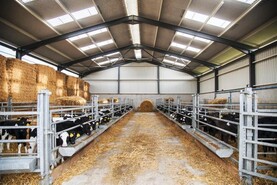



SHARING OPTIONS: